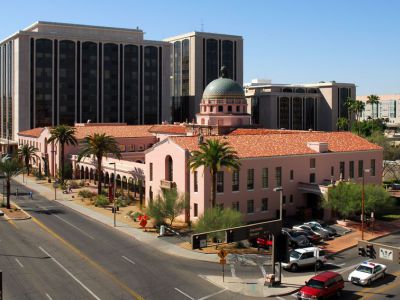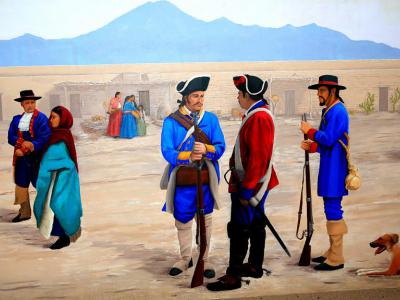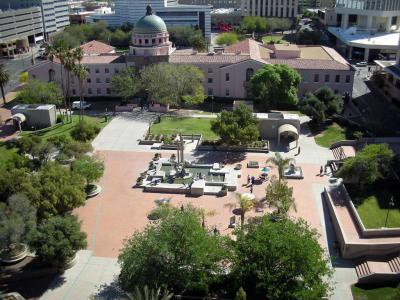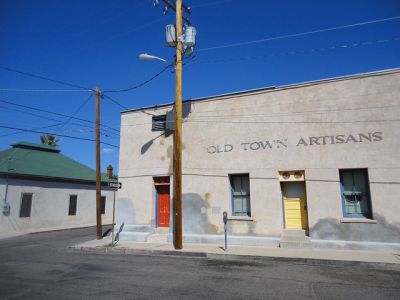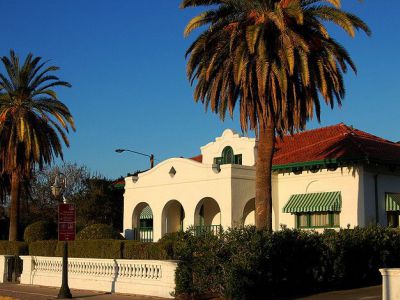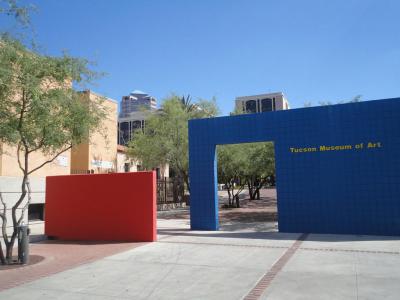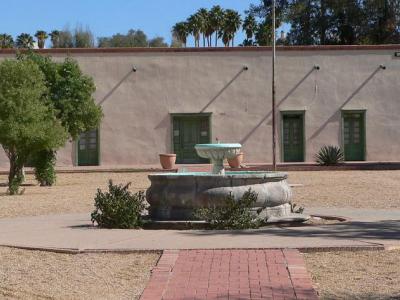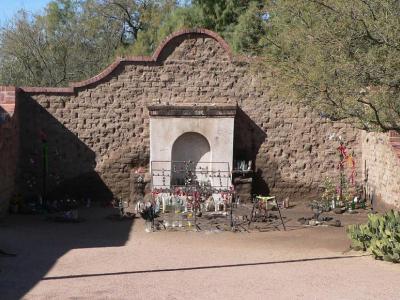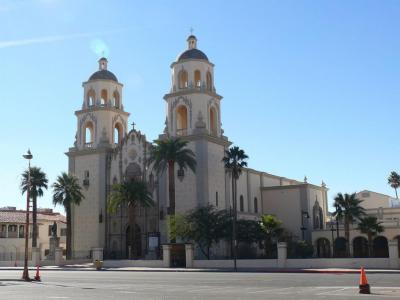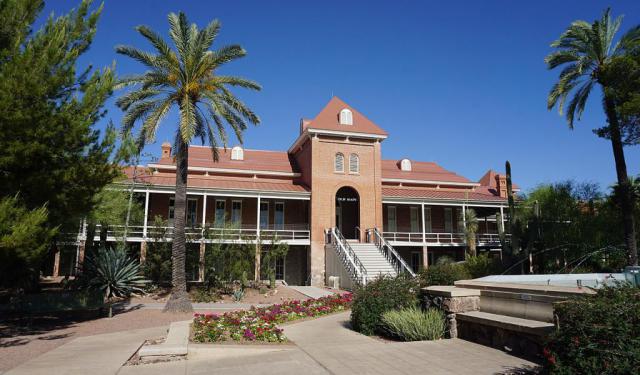
Tucson Downtown Walking Tour (Self Guided), Tucson
Known as “The Old Pueblo” and “Optics Valley,” Tucson, Arizona, is "America's biggest small town" boasting a rich history and global recognition for its contributions to optical science and telescope technology.
The Spanish name, Tucson, is derived from the Uto-Aztecan language, meaning "at the foot of the black hill" – a nod to Sentinel Peak's basalt covering. This rock has since been used to create the large A that visitors can see from the base of the hill.
Tucson was founded in 1775 as a military fort by Hugo O'Conor, a military governor of northern Mexico, who ordered the construction of the Presidio San Agustin del Tucson, the first structure of the nascent city. Eventually, Tucson transitioned from Spanish to Mexican control, following Mexico's independence in 1821, and later to the United States – through the Gadsden Purchase in 1853. It then served as the capital of the Arizona Territory, from 1867 to 1877.
Like other Western US cities, Tucson was built on a grid pattern in the late 19th century, centered around Stone Avenue and Broadway Boulevard. As the city expanded eastward due to geographical constraints in the west, its center shifted, resulting in diverse neighborhoods spread across a vast area.
Downtown Tucson boasts a wealth of historic attractions, such as the Old Presidio neighborhood with the remains of the original fortress, the J Knox Corbett House, the Cathedral of Saint Augustine, and many other landmarks, each showcasing distinct architectural styles from different eras. The likes of the old Pima County Courthouse, designed by Roy Place in 1928 and listed on the National Register of Historic Places, notably add to the area's heritage.
For a deeper dive into Tucson's cultural past, the Tucson Museum of Art and Historic Block provides a comprehensive exploration of the region's artistic and historical legacy.
In the late 2010s, efforts to revitalize Downtown Tucson went underway. Anchored by the Broadway Village shopping center, Central Tucson boasts unique retail spots offering diverse shopping experiences. In particular, art and history enthusiasts will delight in visiting Old Town Artisans, a collection of shops housed in historic adobe buildings.
In essence, exploring Downtown Tucson is a captivating journey, where each corner reveals a new facet of the city's storied past. Whether you're strolling through historic plazas or admiring centuries-old architecture, there's always something to discover in this dynamic urban center. So wait no more! Grab this self-guided opportunity and experience the charm and allure of Downtown Tucson for yourself now!
The Spanish name, Tucson, is derived from the Uto-Aztecan language, meaning "at the foot of the black hill" – a nod to Sentinel Peak's basalt covering. This rock has since been used to create the large A that visitors can see from the base of the hill.
Tucson was founded in 1775 as a military fort by Hugo O'Conor, a military governor of northern Mexico, who ordered the construction of the Presidio San Agustin del Tucson, the first structure of the nascent city. Eventually, Tucson transitioned from Spanish to Mexican control, following Mexico's independence in 1821, and later to the United States – through the Gadsden Purchase in 1853. It then served as the capital of the Arizona Territory, from 1867 to 1877.
Like other Western US cities, Tucson was built on a grid pattern in the late 19th century, centered around Stone Avenue and Broadway Boulevard. As the city expanded eastward due to geographical constraints in the west, its center shifted, resulting in diverse neighborhoods spread across a vast area.
Downtown Tucson boasts a wealth of historic attractions, such as the Old Presidio neighborhood with the remains of the original fortress, the J Knox Corbett House, the Cathedral of Saint Augustine, and many other landmarks, each showcasing distinct architectural styles from different eras. The likes of the old Pima County Courthouse, designed by Roy Place in 1928 and listed on the National Register of Historic Places, notably add to the area's heritage.
For a deeper dive into Tucson's cultural past, the Tucson Museum of Art and Historic Block provides a comprehensive exploration of the region's artistic and historical legacy.
In the late 2010s, efforts to revitalize Downtown Tucson went underway. Anchored by the Broadway Village shopping center, Central Tucson boasts unique retail spots offering diverse shopping experiences. In particular, art and history enthusiasts will delight in visiting Old Town Artisans, a collection of shops housed in historic adobe buildings.
In essence, exploring Downtown Tucson is a captivating journey, where each corner reveals a new facet of the city's storied past. Whether you're strolling through historic plazas or admiring centuries-old architecture, there's always something to discover in this dynamic urban center. So wait no more! Grab this self-guided opportunity and experience the charm and allure of Downtown Tucson for yourself now!
How it works: Download the app "GPSmyCity: Walks in 1K+ Cities" from Apple App Store or Google Play Store to your mobile phone or tablet. The app turns your mobile device into a personal tour guide and its built-in GPS navigation functions guide you from one tour stop to next. The app works offline, so no data plan is needed when traveling abroad.
Tucson Downtown Walking Tour Map
Guide Name: Tucson Downtown Walking Tour
Guide Location: USA » Tucson (See other walking tours in Tucson)
Guide Type: Self-guided Walking Tour (Sightseeing)
# of Attractions: 9
Tour Duration: 2 Hour(s)
Travel Distance: 3.0 Km or 1.9 Miles
Author: anna
Sight(s) Featured in This Guide:
Guide Location: USA » Tucson (See other walking tours in Tucson)
Guide Type: Self-guided Walking Tour (Sightseeing)
# of Attractions: 9
Tour Duration: 2 Hour(s)
Travel Distance: 3.0 Km or 1.9 Miles
Author: anna
Sight(s) Featured in This Guide:
- Pima County Courthouse
- Presidio San Agustin del Tucson
- El Presidio Park
- Old Town Artisans
- Corbett House
- Tucson Museum of Art and Historic Block
- Sosa-Carrillo-Fremont House Museum
- El Tiradito
- Saint Augustine Cathedral
1) Pima County Courthouse
The Pima County Courthouse is a historical building that once served as the main courthouse in the region. From 1930 through 1977 it was home to the Pima County Superior Court. After that point, and through 2015, the courthouse was home to the Pima County Consolidated Justice Court.
Today, tourists in Tucson can visit the Pima County Courthouse to marvel at the Mission Revival and Spanish Colonial Architecture. The building recently underwent renovations that transformed the building to its original adobe color. Previously, the building was known for the pink paint, which was applied in the early 1950s.
The courthouse isn't just beautiful on the outside. Tourists can enjoy the interior of the building while they visit the offices of Southern Arizona Heritage and Visitor Center, which are open daily.
The Pima County Courthouse is on the National Register of Historic Places. One of the most famous outlaws to be tried in this building was gangster John Dillinger. Dillinger and his gang were caught in Tucson in 1934. For four days, visitors were able to pay a fee to walk by the cell to catch a glimpse of the infamous gangster.
Dillinger wasn't the only famous face to grace the halls of the Pima County Courthouse. Actor Clark Gable was tried at the courthouse and found guilty of negligence in a car accident. Some 40 years later, actor Johnny Depp also faced a traffic violation in the courthouse.
The building has also been used for films, including the 1976 version of "A Star is Born" and the 1980 comedy "Stir Crazy."
Today, tourists in Tucson can visit the Pima County Courthouse to marvel at the Mission Revival and Spanish Colonial Architecture. The building recently underwent renovations that transformed the building to its original adobe color. Previously, the building was known for the pink paint, which was applied in the early 1950s.
The courthouse isn't just beautiful on the outside. Tourists can enjoy the interior of the building while they visit the offices of Southern Arizona Heritage and Visitor Center, which are open daily.
The Pima County Courthouse is on the National Register of Historic Places. One of the most famous outlaws to be tried in this building was gangster John Dillinger. Dillinger and his gang were caught in Tucson in 1934. For four days, visitors were able to pay a fee to walk by the cell to catch a glimpse of the infamous gangster.
Dillinger wasn't the only famous face to grace the halls of the Pima County Courthouse. Actor Clark Gable was tried at the courthouse and found guilty of negligence in a car accident. Some 40 years later, actor Johnny Depp also faced a traffic violation in the courthouse.
The building has also been used for films, including the 1976 version of "A Star is Born" and the 1980 comedy "Stir Crazy."
2) Presidio San Agustin del Tucson (must see)
The Presidio San Agustin del Tucson Museum was created to give visitors a taste of life in 1775. This must see location offers edutainment at its finest for all ages. Tourists can see the original Presidio wall, archaeological findings and a dwelling that is more than 150 years old.
The original Presidio was thought to have been constructed in the fall of 1776, but construction and re-construction continued over many decades. It was originally constructed by Spanish soldiers led by Captain Hugh O'Conor, an Irish missionary and the founding father of Tucson.
The Presidio is credited with being the earliest structure in Tucson and the genesis of the city itself. Even the name of Tucson refers to the location of the Presidio at the "black base" of Sentinel Peak.
It remained a working fort through 1856 when the fort was demolished so that materials could be used to make new buildings. Because the last remaining wall of the Presidio was torn down in 1918, the structure visitors now see is a recreation based on archaeological findings and original sketches.
Tourists will see the Siqueiros-Jacome Home, which now hosts the gift shop. This home was built in the 1860s in the fashion of a typical Sonoran row home. The house belonged to Soledad Jacome and her husband Juan Siqueiros from 1866 through the early 1870s when Juan disappeared. Soledad then worked as a seamstress to support her six daughter until her death in 1911.
Visitors also have the opportunity to learn about the native people who lived in the region as well as the first territorial settlers. They can take guided tours, watch re-enactments and enjoy demonstrations on select days.
Demonstrations at the Presidio include cotton and wool carding, weaving, spinning, soldier demonstrations, musket shooting and tortilla making. There are also special events that include winter gardening workshops, lectures about crime in territorial Tucson and walking ghost tours.
Why You Should Visit:
The Presidio San Agustin del Tucson offers an entertaining look into the past. Those who are new to the area, vacationing or who live in Tucson and want to know more about the region's history can gain a great deal of insight while touring the rebuilt Presidio walls.
The original Presidio was thought to have been constructed in the fall of 1776, but construction and re-construction continued over many decades. It was originally constructed by Spanish soldiers led by Captain Hugh O'Conor, an Irish missionary and the founding father of Tucson.
The Presidio is credited with being the earliest structure in Tucson and the genesis of the city itself. Even the name of Tucson refers to the location of the Presidio at the "black base" of Sentinel Peak.
It remained a working fort through 1856 when the fort was demolished so that materials could be used to make new buildings. Because the last remaining wall of the Presidio was torn down in 1918, the structure visitors now see is a recreation based on archaeological findings and original sketches.
Tourists will see the Siqueiros-Jacome Home, which now hosts the gift shop. This home was built in the 1860s in the fashion of a typical Sonoran row home. The house belonged to Soledad Jacome and her husband Juan Siqueiros from 1866 through the early 1870s when Juan disappeared. Soledad then worked as a seamstress to support her six daughter until her death in 1911.
Visitors also have the opportunity to learn about the native people who lived in the region as well as the first territorial settlers. They can take guided tours, watch re-enactments and enjoy demonstrations on select days.
Demonstrations at the Presidio include cotton and wool carding, weaving, spinning, soldier demonstrations, musket shooting and tortilla making. There are also special events that include winter gardening workshops, lectures about crime in territorial Tucson and walking ghost tours.
Why You Should Visit:
The Presidio San Agustin del Tucson offers an entertaining look into the past. Those who are new to the area, vacationing or who live in Tucson and want to know more about the region's history can gain a great deal of insight while touring the rebuilt Presidio walls.
3) El Presidio Park
Between the Old County Courthouse and City Hall lies El Presidio Park. What looks like a simple park actually has a very long and storied history.
The land was first used as a park in 1776. It also served as a military garrison for the Spanish and American settlers. In 1862, the area was designated as a free zone. It wasn't until the 1970s that it became a park once more.
Today, El Presidio Park is nearly three acres of green space, a rose garden, veterans memorials and art installations. It is not uncommon to see festivals taking place in the park, including the Tucson Folk Festival and the Tucson Meet Yourself Festival. It is also a popular spot for political rallies, celebrations and weddings.
Tourists should stop at each of the memorial statues to develop an understanding of the changes that took place over the years. They can also see an original marker of the walls of the old Presidio.
The land was first used as a park in 1776. It also served as a military garrison for the Spanish and American settlers. In 1862, the area was designated as a free zone. It wasn't until the 1970s that it became a park once more.
Today, El Presidio Park is nearly three acres of green space, a rose garden, veterans memorials and art installations. It is not uncommon to see festivals taking place in the park, including the Tucson Folk Festival and the Tucson Meet Yourself Festival. It is also a popular spot for political rallies, celebrations and weddings.
Tourists should stop at each of the memorial statues to develop an understanding of the changes that took place over the years. They can also see an original marker of the walls of the old Presidio.
4) Old Town Artisans
As you are walking through downtown Tucson you will want to carve some time to visit Old Town Artisans. This name refers to a historic block of shops in the downtown area that focus on artistry, unique shopping and dining establishments.
Also known as the Art Shops District, Old Town Artisans is held in an area of the city that was once home to the stables and the old fort's north wall. It was also the location for a number of individuals who were important to the early days of Tucson's development. Residents of the area were the workers who supported the town and its residents, including clerks, nurses and grocers.
Stroll through Old Town Artisans to find a wide range of shops and experiences. Visitors might see a second-hand thrift shop, jewelers, a tattoo parlor, a bakery, a record shop, pubs and, of course, many artists and galleries.
Also known as the Art Shops District, Old Town Artisans is held in an area of the city that was once home to the stables and the old fort's north wall. It was also the location for a number of individuals who were important to the early days of Tucson's development. Residents of the area were the workers who supported the town and its residents, including clerks, nurses and grocers.
Stroll through Old Town Artisans to find a wide range of shops and experiences. Visitors might see a second-hand thrift shop, jewelers, a tattoo parlor, a bakery, a record shop, pubs and, of course, many artists and galleries.
5) Corbett House
The Corbett House is a popular stop for lovers of arts and architecture. This Mission Revival style home belonged to the J. Knox Corbett family from the last 19th century through the 1960s.
The Corbett family was a prominent family of Tucson, thus the house was one that was frequently a hub for parties and society events. It was also furnished with fine European arts and furniture. It houses one of the area's first air conditioning units. It was also rumored to hold a gin still during prohibition.
J. Knox Corbett was a mayor of Tucson and his wife, Lizzie Hughes Corbett, was the daughter of Tucson City Council member Samuel C. Hughes.
Visitors can take guided tours of the home on Sundays. It is not open to the general public.
The Corbett family was a prominent family of Tucson, thus the house was one that was frequently a hub for parties and society events. It was also furnished with fine European arts and furniture. It houses one of the area's first air conditioning units. It was also rumored to hold a gin still during prohibition.
J. Knox Corbett was a mayor of Tucson and his wife, Lizzie Hughes Corbett, was the daughter of Tucson City Council member Samuel C. Hughes.
Visitors can take guided tours of the home on Sundays. It is not open to the general public.
6) Tucson Museum of Art and Historic Block (must see)
The Tucson Museum of Art is the area's largest art museum. It includes 74,000 square feet of exhibit space, which is filled with permanent and revolving works of art. The Historic Block is four acres of space that includes historic homes that have been restored to their original grandeur.
Revolving exhibits at the Tucson Museum of Art vary in scope and nature. Most revolving exhibits are present in the museum for about five months, which gives visitors plenty of time to plan trips around their favorite pieces. In the past, revolving exhibits have included contemporary art, modern art, colonial pieces and Latin American artist galleries, among many others.
Ongoing exhibits include arts from the American Southwest, special exhibits from private collections and much more. Patrons will see works from artists such as Max Weber, John Chamberlain, Chuck Close, Bill Schenck and Jasper Johns.
The Historic Block includes La Casa Cordova, one of Tucson's oldest buildings. Other homes include the Corbett House, the Fish House, the Romero House and the Stevens/Duffield House.
Why You Should Visit:
The Tucson Museum of Art and Historic Block is arguably the most important stop on your tour of Tucson. This area encompasses many of the city's oldest homes and greatest achievements in art and architecture. There may be no better learning experience than a day spent at this museum and touring the historic homes.
Tips:
Check with the museum website before venturing out to make sure a favorite home is open. The museum website also lists any educational events that may be of interest.
Revolving exhibits at the Tucson Museum of Art vary in scope and nature. Most revolving exhibits are present in the museum for about five months, which gives visitors plenty of time to plan trips around their favorite pieces. In the past, revolving exhibits have included contemporary art, modern art, colonial pieces and Latin American artist galleries, among many others.
Ongoing exhibits include arts from the American Southwest, special exhibits from private collections and much more. Patrons will see works from artists such as Max Weber, John Chamberlain, Chuck Close, Bill Schenck and Jasper Johns.
The Historic Block includes La Casa Cordova, one of Tucson's oldest buildings. Other homes include the Corbett House, the Fish House, the Romero House and the Stevens/Duffield House.
Why You Should Visit:
The Tucson Museum of Art and Historic Block is arguably the most important stop on your tour of Tucson. This area encompasses many of the city's oldest homes and greatest achievements in art and architecture. There may be no better learning experience than a day spent at this museum and touring the historic homes.
Tips:
Check with the museum website before venturing out to make sure a favorite home is open. The museum website also lists any educational events that may be of interest.
7) Sosa-Carrillo-Fremont House Museum
The Sosa-Carrillo-Fremont House Museum is a historic adobe house located in downtown Tucson. Built in the mid-19th century, the house is a remarkable example of traditional Sonoran architecture and offers a fascinating glimpse into the lives of the people who lived in the area during that time. Today, the museum is a popular destination for visitors who want to learn more about Tucson's rich cultural history and experience the unique charm of the region's early architecture.
The Sosa-Carrillo-Fremont House was built in 1870 and is named for its original owners, the Sosa and Carrillo families, who were prominent Tucson residents. The house was later purchased by John C. Fremont, a famous explorer and politician, who used it as his family home during his time in Tucson. Today, the museum is managed by the Arizona Historical Society and offers visitors a wide range of exhibits and educational programs that explore the history and culture of the region.
Visitors to the Sosa-Carrillo-Fremont House Museum can take a guided tour of the house and its gardens, which have been beautifully restored to their original condition. The museum also offers a variety of special events and programs throughout the year, including lectures, workshops, and cultural festivals.
The Sosa-Carrillo-Fremont House was built in 1870 and is named for its original owners, the Sosa and Carrillo families, who were prominent Tucson residents. The house was later purchased by John C. Fremont, a famous explorer and politician, who used it as his family home during his time in Tucson. Today, the museum is managed by the Arizona Historical Society and offers visitors a wide range of exhibits and educational programs that explore the history and culture of the region.
Visitors to the Sosa-Carrillo-Fremont House Museum can take a guided tour of the house and its gardens, which have been beautifully restored to their original condition. The museum also offers a variety of special events and programs throughout the year, including lectures, workshops, and cultural festivals.
8) El Tiradito
The crumbling bricks of the shrine of El Tiradito is one of the most popular tourist spots in Tucson. This is largely due not to the construction or facade but to the unique history of the shrine.
El Tiradito is dedicated to the memory of a man named Juan Oliveras. The legend is that Oliveras was married but was involved in a torrid love affair with his mother-in-law. He was caught by the woman's husband who killed Oliveras with an axe. The church, unwilling to bury the man in consecrated ground, buried him in the spot where he was murdered.
Visitors can pay their respects to Juan Oliveras by lighting candles at El Tiradito. Also known as the wishing shrine, many write their wishes on small slips of paper and slide them between the cracks of the stones. In addition to the faithful who leave these religious objects, El Tiradito is frequented and favored by many Tucsonans, including writers, poets, and other members of the town's artistic community.
According to the Phoenix New Times publication, El Tiradito is the only Catholic shrine in the United States dedicated to a sinner buried in unconsecrated ground. There is no cost to visit this spot in the area that is now known as Barrio Libre near downtown Tucson.
El Tiradito is dedicated to the memory of a man named Juan Oliveras. The legend is that Oliveras was married but was involved in a torrid love affair with his mother-in-law. He was caught by the woman's husband who killed Oliveras with an axe. The church, unwilling to bury the man in consecrated ground, buried him in the spot where he was murdered.
Visitors can pay their respects to Juan Oliveras by lighting candles at El Tiradito. Also known as the wishing shrine, many write their wishes on small slips of paper and slide them between the cracks of the stones. In addition to the faithful who leave these religious objects, El Tiradito is frequented and favored by many Tucsonans, including writers, poets, and other members of the town's artistic community.
According to the Phoenix New Times publication, El Tiradito is the only Catholic shrine in the United States dedicated to a sinner buried in unconsecrated ground. There is no cost to visit this spot in the area that is now known as Barrio Libre near downtown Tucson.
9) Saint Augustine Cathedral (must see)
The Saint Augustine Cathedral is one of the oldest and most beautiful buildings in Tucson. Construction on the cathedral began in 1858 and was completed 10 years later. The cathedral has undergone many reconstruction projects since then including one that demolished and rebuilt most of the structure.
Pope Pius XI was pope at the time the building was erected. Therefore, it is his coat of arms that adorns the cathedral. There is also a 12th century crucifix from Pamplona, Spain that hangs in the vestibule. The cathedral's interior is just as impressive as its exterior, with a soaring nave, ornate altars, and intricate murals and paintings. The cathedral also houses a number of historic artifacts, including a 17th-century altar and a 19th-century pipe organ.
Today, the church remains the mother church of the Roman Catholic Diocese of Tucson. Visitors are welcome in the church during services or special events. Even for those simply wishing to walk by, the cathedral is worth stopping by to enjoy the stained glass windows and the representation of the Mission San Xavier del Bac.
Why You Should Visit:
Lovers of architecture will be stunned by the artistry that went into building this cathedral. Even those who are not Catholic will walk away with a sense of awe at the building's beauty.
Tips:
Those who want to see the inside of the cathedral should plan a weekend trip, though confessions are open on Wednesdays and Fridays.
Pope Pius XI was pope at the time the building was erected. Therefore, it is his coat of arms that adorns the cathedral. There is also a 12th century crucifix from Pamplona, Spain that hangs in the vestibule. The cathedral's interior is just as impressive as its exterior, with a soaring nave, ornate altars, and intricate murals and paintings. The cathedral also houses a number of historic artifacts, including a 17th-century altar and a 19th-century pipe organ.
Today, the church remains the mother church of the Roman Catholic Diocese of Tucson. Visitors are welcome in the church during services or special events. Even for those simply wishing to walk by, the cathedral is worth stopping by to enjoy the stained glass windows and the representation of the Mission San Xavier del Bac.
Why You Should Visit:
Lovers of architecture will be stunned by the artistry that went into building this cathedral. Even those who are not Catholic will walk away with a sense of awe at the building's beauty.
Tips:
Those who want to see the inside of the cathedral should plan a weekend trip, though confessions are open on Wednesdays and Fridays.
Walking Tours in Tucson, Arizona
Create Your Own Walk in Tucson
Creating your own self-guided walk in Tucson is easy and fun. Choose the city attractions that you want to see and a walk route map will be created just for you. You can even set your hotel as the start point of the walk.
University of Arizona Walking Tour
Founded in 1885, the University of Arizona (U of A) was the first university in the state, and so far has been the only representative from the state of Arizona in the Association of American Universities.
The U of A campus in Tucson proudly showcases a number of landmarks, each with its own story and unique allure. Among these, the Old Main building, an architectural gem, completed in 1891,... view more
Tour Duration: 2 Hour(s)
Travel Distance: 2.8 Km or 1.7 Miles
The U of A campus in Tucson proudly showcases a number of landmarks, each with its own story and unique allure. Among these, the Old Main building, an architectural gem, completed in 1891,... view more
Tour Duration: 2 Hour(s)
Travel Distance: 2.8 Km or 1.7 Miles
Tucson Architecture Walking Tour
Just as any city is not an accident but the result of coherent visions and aims, Tucson's architectural landscape bears witness to the city's profound historical narrative and cultural melange.
From the majestic belfries of the Saint Augustine Cathedral, adorned with the Spanish Colonial Revival-style opulence, to the resplendent Scottish Rite Cathedral (also known as the Masonic... view more
Tour Duration: 1 Hour(s)
Travel Distance: 2.1 Km or 1.3 Miles
From the majestic belfries of the Saint Augustine Cathedral, adorned with the Spanish Colonial Revival-style opulence, to the resplendent Scottish Rite Cathedral (also known as the Masonic... view more
Tour Duration: 1 Hour(s)
Travel Distance: 2.1 Km or 1.3 Miles
The Most Popular Cities
/ view all
